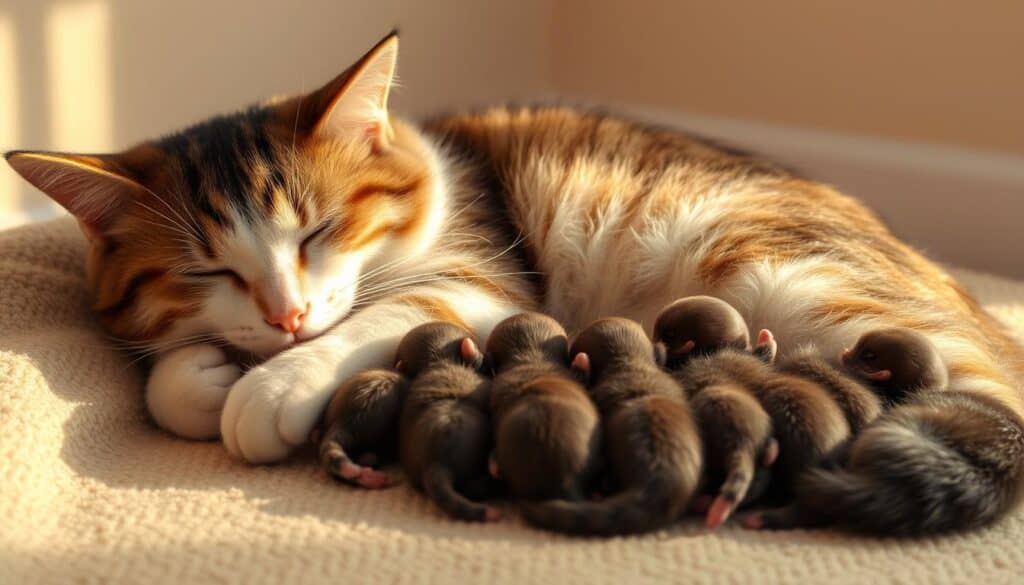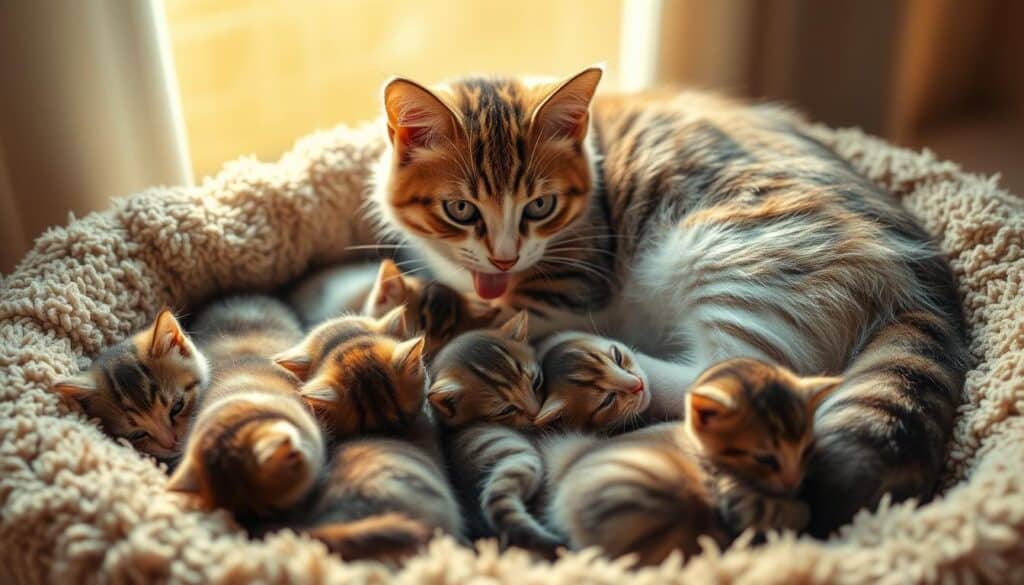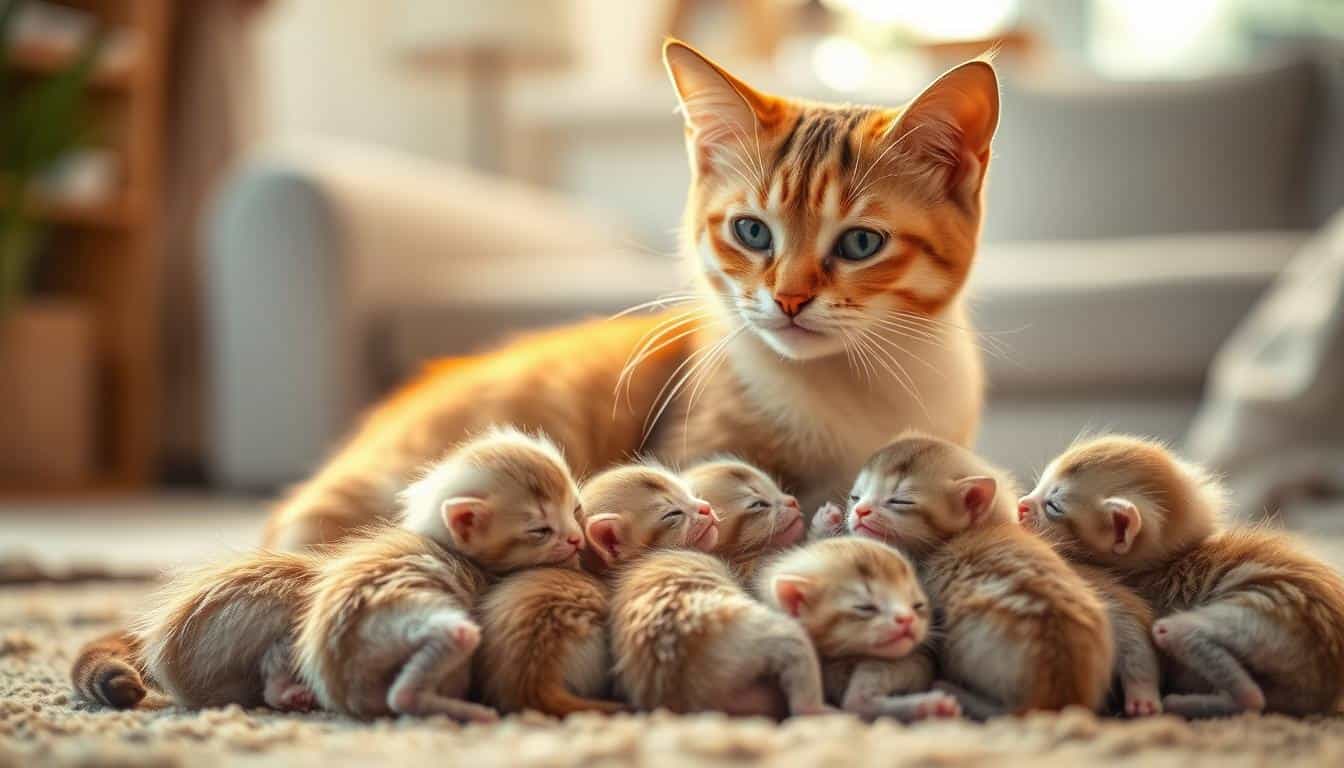Knowing how many kittens a cat can have is key for any pet owner. Domestic cats have a high *feline breeding capacity*. This can change a lot based on genetics, breed, and environment. Each time a cat breeds, it can have a different number of kittens.
It’s vital for cat lovers to understand their pet’s reproductive health. We’ll explore the world of cat reproduction in this article. We’ll help owners understand the numbers and the care needed for these playful felines.
Key Takeaways
- Understanding a cat’s breeding capacity is important for making good choices.
- Genetics and breed greatly affect the number of kittens born.
- Environmental factors also play a big role in cat reproductive health.
- Being a responsible pet owner means knowing about kitten production.
- Cats can have a wide range of litter sizes due to different factors.
Understanding Feline Reproduction
Feline reproduction is truly fascinating. Knowing about the cat reproductive cycle is key for those interested in breeding. Female cats can have multiple heat cycles a year. This allows them to mate and conceive at certain times. We’ll dive into the details of these cycles and what affects fertility.
The Cat’s Reproductive Cycle
The cat’s reproductive cycle has several stages. These include proestrus, estrus (heat), metestrus, and anestrus. Estrus is the stage when a female cat is ready to mate. This cycle happens several times a year, depending on daylight and the cat’s health.
During estrus, female cats may show changes in behavior. These changes signal they are ready to breed.
Factors Affecting Fertility
Many things can affect a cat’s fertility. Age is a big factor, as female cats can breed from five months old. A balanced diet is also important for reproductive health. Health conditions can also impact fertility.
For successful feline breeding, it’s vital to consider these factors. This ensures female cats stay healthy and can reproduce well.
How Many Kittens Can a Cat Have in a Litter?
Knowing how many kittens a cat can have is key for cat owners. Most domestic cats have between two to six kittens. This number shows a mix of genetics and environment.
Typical Litter Sizes
Typically, domestic cats have two to six kittens. But, some breeds can have more or less. For example, Maine Coons often have bigger litters than Singapuras. Knowing this helps breeders and owners get ready for new kittens.
Variability in Litter Numbers
Litter size can vary a lot. A cat’s age, health, and breeding history matter. Younger cats usually have smaller litters, while older ones might have more.
Things like stress and nutrition also play a part. Knowing this helps owners set realistic expectations for when kittens will arrive.

How Many Kittens Can a Cat Have in a Year?
To figure out how many kittens a cat can have in a year, we need to know about their reproductive abilities. Female cats usually have breeding cycles every year. They go into heat several times, which means they can have many litters.
In the best conditions, a female cat might have two to three litters a year. Each litter can have four to eighteen kittens. This shows how important it is to understand cat breeding to manage their population well.
Many animal welfare groups suggest spaying and neutering cats to control their numbers. These actions help keep the cat population balanced. They also make sure cats live happy, healthy lives.
How Many Kittens Can a Cat Have in Their Lifetime?
Understanding how many kittens a cat can have in its lifetime is key to knowing about feline reproduction. Cats usually live between 12 to 15 years. This time frame affects how many kittens a cat can have.
During these years, a cat may have litters. These litters happen over a period of about five to eight years. This shows how a cat’s lifespan impacts its kitten production.
Average Lifespan and Breeding Years
A cat could have over 50 kittens in its lifetime. This depends on how often it breeds and the size of each litter. This number shows how cats can have many kittens if they are not spayed or neutered.
Each breeding season can lead to more litters. This causes the number of kittens to grow quickly.
Impact of Spaying and Neutering
Spaying and neutering greatly affect a cat’s kitten count. These procedures prevent unwanted pregnancies. They make pets healthier and longer-lived.
They also help reduce the number of kittens in shelters. This is good for both pets and communities.

How Many Kittens Can a Cat Have at Once?
When we talk about how many kittens a cat can have, it’s key to know the average is three to five. But, this number can change a lot. It depends on the cat’s genes, age, and health.
In some cases, a cat might surprise you with up to twelve kittens at once. This shows how different cat breeding can be.
If you’re thinking about getting a cat, it’s good to know not every litter will be the same. A young cat or a first-time mom might have one or two kittens. But, older and healthy cats might have more, showing their strong reproductive abilities.
Knowing how many kittens a cat can have is important for cat owners. It helps plan for the kittens’ care, giving them a great start. It also helps breeders know what to expect, creating a healthy space for the mom and kittens.




